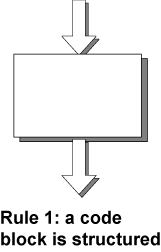What if there is a bug?

If the entry conditions are correct,
but the exit conditions are wrong,
the bug must be in the block.
This is not true if execution is allowed to
jump into or out of a block.
The bug might be anywhere in the program.
Debugging under these conditions is much harder.
Rule 1 of Structured Programming:
A code block is structured.
In flow charting terms, a box with a single
entry point and single exit point is
structured.
This may look obvious, but that is the idea.
Structured programming is a way of making it
obvious that program is correct.
(Or, making it obvious where there is a problem.)
Structured programming languages show code blocks with pairs of braces, { ... },
or begin end pairs or other means.
Assembly language and older programming languages, such as early versions of FORTRAN and BASIC,
were not designed with structured programming in mind.
They do not have syntax for showing
program blocks or the other structures of structured programming.
However, it is still possible (and essential) to do structured programming in these languages.
You (the programmer) must design the code using structuring principles.
Then, when coding you must follow your design.
These old languages included the notorious GOTO statement which sent control
from one point in a program to any other point in a program,
directly violating Rule One.
This was disastrous.

